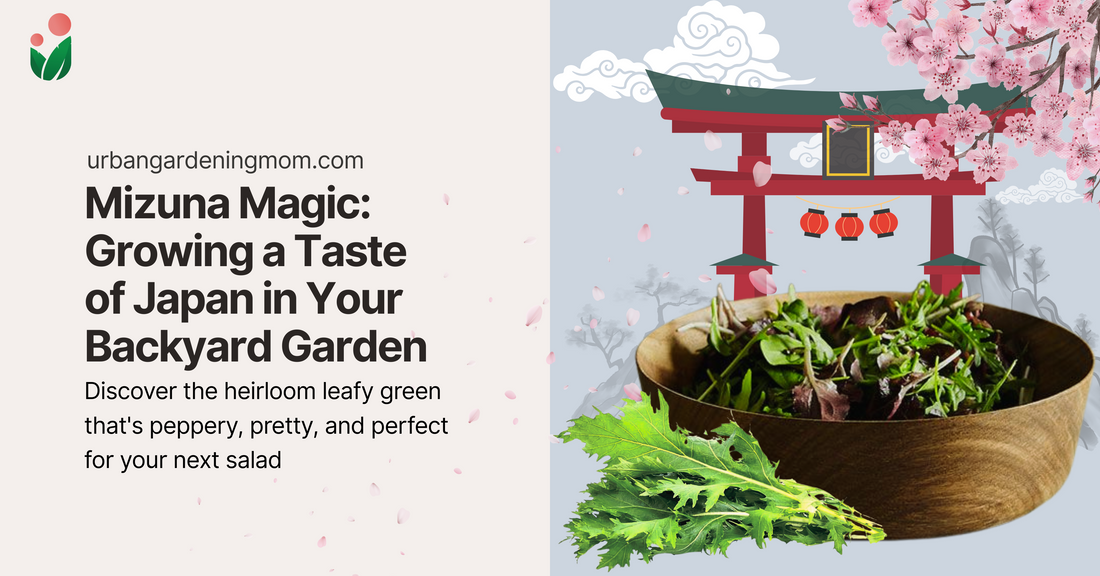
Mizuna Magic: Growing a Taste of Japan in Your Backyard Garden
Share
Discover the heirloom leafy green that's peppery, pretty, and perfect for your next salad.
One of the unexpected joys I’ve discovered in my gardening journey? Uncovering the stories behind the plants I grow. Because sometimes, vegetables aren't just ingredients — they carry with them culture, history, and heritage.
Take mizuna, for example. This lovely green has recently become one of my favorite leafy vegetables. Also known as Japanese mustard green, mizuna offers a unique flavor that’s sharp, mildly peppery, and ever-so-slightly tangy. It’s like arugula's quieter, more elegant cousin — bold enough to stand out, but refined enough to blend seamlessly in your salads, pizzas, and stir-fries.
🇯🇵 A Taste of Kyoto’s Past
If you've ever strolled through a traditional Japanese market, you’ve likely seen mizuna bundled in beautiful green bunches, ready to be tossed into miso soups, hotpots (nabe), or pickled dishes.
Mizuna isn’t just a trendy superfood — it’s a cultural heirloom. In fact, it’s considered a “Kyo Yasai,” a term for traditional vegetables grown in the Kyoto region, once the seat of Japan’s imperial family. These vegetables were so prized, they were reserved for the royal kitchens during the Edo period.
Beyond its noble origins, mizuna is beloved for its vibrant green color and delicate, feather-like leaves — a visual treat that reflects the Japanese respect for beauty in food.
And of course, it's nutrient-rich, packed with vitamins A, C, K, and beta-carotene, making it both a beautiful and functional addition to your diet.
🌱 Growing Mizuna in the Philippines
Surprisingly, mizuna grows incredibly well in tropical gardens! Even though it’s not something you usually find in supermarkets, mizuna seeds are available in some local seed brands, and they’re easy to grow at home — even for beginners.
Here’s how to get started:
-
🌿 Container size: Use a pot that’s at least 6 inches deep and wide. Mizuna doesn’t need much space.
-
🪴 Soil: Use a well-draining, compost-rich potting mix.
-
💧 Watering: Keep the soil evenly moist, not soggy. Water when the top inch of soil feels dry.
-
🌞 Sunlight: Mizuna prefers partial sun to full sun, but a little shade during extreme heat is welcome.
🧄 Fertilizer & Care Tips
Mizuna is a quick grower and loves compost-rich soil. Feed it with organic fertilizers like vermicast or processed chicken manure every two weeks for best results. Watch out for pests like aphids and flea beetles — despite its peppery bite, it’s not immune!
To protect your crop:
-
Spray with a mild neem oil solution weekly.
-
Avoid overwatering to discourage fungal growth.
✂️ When to Harvest
You can start harvesting mizuna:
-
🌱 As microgreens — in as early as 10–14 days.
-
🌿 As baby leaves — around 4 weeks in.
-
🍃 Full size — when leaves reach 6–8 inches long.
Harvesting young gives you the best flavor and texture. Older leaves become tougher and more pungent — unless you're stir-frying them or making soup.
🍜 From Garden to Table: What to Cook with Mizuna
Mizuna is a flexible leafy green you can:
-
Mix into salads for a peppery punch
-
Toss into stir-fries and noodle dishes
-
Add to miso soup or ramen for a crisp bite
-
Use as a pizza topping or wrap in rice paper rolls
If you’re a fan of arugula, you’ll find mizuna just as exciting — but with a unique Japanese twist.
💬 Let’s Chat!
Have you grown mizuna in your backyard or balcony garden?
Do you have a favorite Japanese recipe that features this heirloom green?
Share your experience in the comments! I’d love to hear what dishes you’ve tried — or how you added your own Pinoy twist to this beautiful veggie. 💚

1 comment
Thanks for the helpful article.